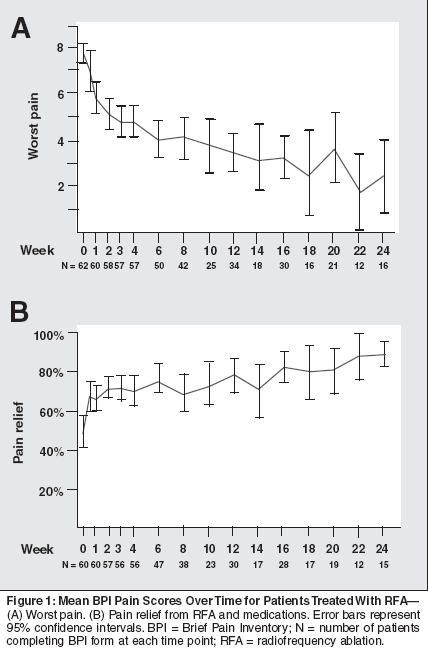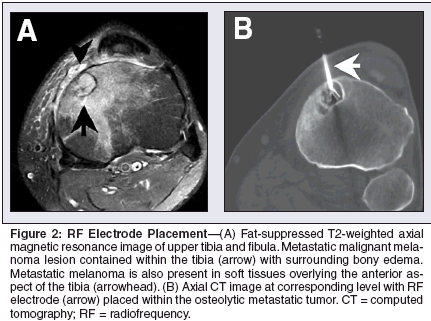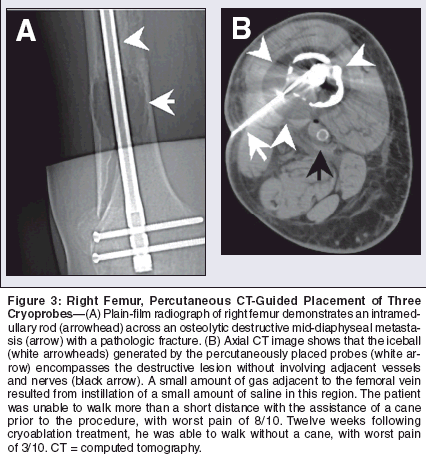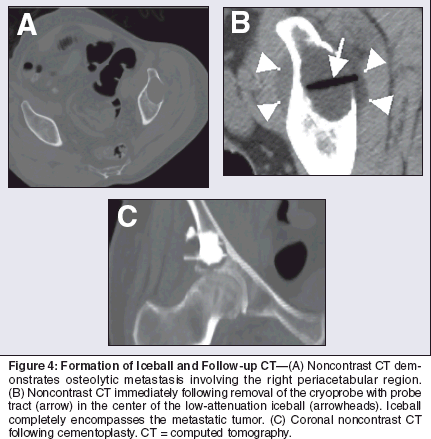Percutaneous Ablation: Safe, Effective Treatment of Bone Tumors
Percutaneous radiofrequency ablation (RFA) of osteoid osteomashas replaced surgical excision as the preferred method for treatment ofthese benign lesions, due to high effectiveness and low morbidity. BothRFA and cryoablation are safe and effective for palliation of pain dueto metastatic disease in patients who have failed conventional therapies.These image-guided treatments can be performed precisely, allowingsafe treatment of complex metastatic tumors. A single ablationtreatment is effective in most patients, is well tolerated, and provides along duration of pain relief.
Percutaneous radiofrequency ablation (RFA) of osteoid osteomas has replaced surgical excision as the preferred method for treatment of these benign lesions, due to high effectiveness and low morbidity. Both RFA and cryoablation are safe and effective for palliation of pain due to metastatic disease in patients who have failed conventional therapies. These image-guided treatments can be performed precisely, allowing safe treatment of complex metastatic tumors. A single ablation treatment is effective in most patients, is well tolerated, and provides a long duration of pain relief.
Ablative techniques have rapidly evolved and have been proven effective for treatment of benign skeletal lesions and, more recently, for palliation of painful metastatic skeletal disease. Treatment of primary bone lesions is largely restricted to benign lesions, such as osteoid osteomas, as a single-modality treatment or as an adjunct to surgical resection.[1-4] The use of ablation techniques for treatment of metastatic disease has developed because of the often disabling pain cancer patients experience. This pain can persist despite use of conventional therapies, including external beam radiation and opioid analgesics.[5-8] Skeletal LesionsBenign Skeletal Lesions:
Osteoid Osteoma
Treatment of benign skeletal lesions with percutaneous ablation methods is an attractive alternative to or replacement for surgical resection because of the high effectiveness and low morbidity associated with these techniques. Osteoid osteomas are relatively common, accounting for approximately 10% of benign bone tumors.[9] Prior to 1997 they were treated by surgical excision. Despite the typical small size of the lesion, the operative resection could be extensive but often incomplete.[3] With improved precise localization using CT, the nidus of the lesion can be effectively located and the lesion completely treated with percutaneous radiofrequency ablation (RFA).[1,2,10-12] Rosenthal has reported a 91% success rate for RFA as the initial treatment (107 of 117 procedures) and 60% for recurrent lesions (6 of 10 procedures).[4] Rosenthal also reported no significant difference in the rate of recurrence when osteoid osteoma lesions were treated with either surgical excision or percutaneous ablation.[ 3] Because of the equal efficacy of surgery compared with RFA and in light of the relatively low morbidity and lower costs associated with the percutaneous method,[13] most centers now consider RFA to be the standard treatment for osteoid osteoma. Malignant Skeletal Lesions:
Painful Metastatic Disease
Skeletal metastases are a common problem for cancer patients. They can have complications including pain, fractures, and decreased mobility that often reduce performance status, affect a patient's quality of life, and lead to depression and anxiety.[14,15] External beam radiation therapy (RT) is the current standard of care for cancer patients who present with localized bone pain. This treatment results in a reduction in pain for the majority of these patients; however, 20% to 30% do not experience pain relief, and few options exist for these patients.[16-21] Pain relief from RT may be transient for more than 50% of patients at a median of 15 weeks after completion of RT therapy.[22] Unfortunately, patients who have recurrent pain at a previously irradiated metastatic site are often not eligible for further RT secondary to limitations in normal tissue tolerance. Additionally, metastatic disease in this patient population is frequently refractory to standard chemotherapy or hormonal therapy. Surgery, which is usually reserved for impending fracture, is not always an option when patients have advanced disease and poor functional status. Radiopharmaceuticals, which have known benefit in patients with diffuse painful bony metastases, are not considered standard of care for patients with isolated, painful lesions. Analgesics remain the only alternative treatment option for many patients with painful metastatic disease. But obtaining sufficient pain control often involves side effects, such as constipation, nausea, and sedation. Percutaneous Radiofrequency Ablation A recent feasibility clinical trial and a subsequent international multicenter clinical trial of the use of percutaneous RFA for treatment of painful metastatic lesions involving bone found that this procedure is safe and provides significant relief of pain.[5,7,8] It is important to note that these patients had failed conventional treatments, including RT and chemotherapy. They reported durable significant decreases in worst pain in a 24-hour period and a high level of pain relief (Figure 1). A total of 59 of 62 patients (95%) experienced a decrease in pain that was considered clinically significant using a predefined validated end point (≥ twopoint drop in worst pain in a 24-hour period).[23] Significant adverse events following the procedure were noted in four patients (6.5%).

Selection of patients for this treatment requires that they have significant pain (≥ 4/10 worst pain in a 24-hour period) and that the painful disease is limited to a few osteolytic metastases. The portions of metastatic tumors that are within 1 cm of critical structures-including bowel, bladder, spinal cord, or motor nerves-must be avoided to prevent damage to these structures. For example, a patient with metastatic melanoma had a painful metastasis involving the proximal tibia (Figure 2). Two separate deployments of the RF electrode were performed, treating both the osseous metastasis and the metastasis overlying the tibia. Pain in the treated area was markedly improved over 3 to 4 weeks and completely eliminated after 6 weeks. Treatment response was durable over the 24-week follow-up period.


Percutaneous Cryoablation Cryoablation has a long history of successful treatment of neoplasms in several organs, including prostate, kidney, liver, and the uterus. First-generation devices were limited to intraoperative use because of their large diameter, the use of liquid nitrogen for tissue cooling, and the lack of wellinsulated probes. Newly developed percutaneous cryoprobes are based on delivery of argon gas through a segmentally insulated probe, with rapid expansion of the gas resulting in rapid cooling, reaching -100oC within a few seconds. Active thawing of the iceball is achieved by actively instilling helium gas, instead of argon gas, into the cryoprobes. As part of an ongoing prospective clinical trial, we have used cryoablation to treat 14 patients with painful metastatic disease involving bone. This effort involves patients who have one or two painful osteolytic lesions that cause ≥ 4/10 pain in a 24-hour period. Patients' response to the treatment is assessed regularly over a 2-year period using the Brief Pain Inventory-Short Form (BPI), a validated visual analog scale for assessment of patient pain. A 72-year-old man with metastatic renal cell carcinoma to the midshaft of the femur had 6/10 worst pain in a 24-hour period despite previous external beam radiation and intramedullary rod placement. He was treated by percutaneous computed tomography (CT)-guided placement of three cryoprobes (Figure 3). The iceball that was generated was monitored with intermittent CT imaging to both treat the target lesion and avoid the adjacent femoral artery and vein and the sciatic nerve. Pain from the metastatic lesion was markedly reduced following treatment and, most importantly, the patient reported an improved quality of life with resumption of an active lifestyle. Preliminary analysis of the patients treated to date is encouraging. Prior to cryoablation, the mean score for worst pain in a 24-hour period was 6.7/10 with a range of 5/10 to 10/10. At 4 weeks after cryoablation, the mean score for worst pain in a 24- hour period decreased to 3.8/10 (standard deviation = 0.5, P = .0003). During the follow-up, 86% of the treated patients reported at least a three-point drop in their worst pain, with 50% reporting complete relief of pain. All patients who were prescribed narcotics prior to the procedure reported a reduction in the use of narcotic analgesic medications at some time following cryoablation. No serious complications have been observed. Some lesions at risk for fracture may also be treated with ablation followed by cementoplasty the next day. A 65-year-old man with lung cancer presented with left hip pain on walking. Upon CT examination an osteolytic supra-acetabular metastasis with preserved cortex at the level of the hip joint (Figure 4A) was found. Treatment considerations included resection and stabilization of the acetabulum because of fracture risk, radiation therapy, and percutaneous ablation followed by cementoplasty. The patient elected for the percutaneous approach and was treated with cryoablation and cementoplasty on the following day (Figures 4B and 4C). He reports no pain in the treated region, and no fracture or progression has occurred at the treated site after 18 months. Both cryoablation and RFA are effective for palliation of pain due to metastatic disease in patients who have failed conventional therapies. The significant advantages of percutaneous cryoablation relative to RF ablation for treatment of painful metastases are as follows:
- The iceball, which defines the limits of the zone of ablation, can be readily identified with CT imaging.
- The simultaneous use of multiple cryoprobes allows generation of large zones of ablation (> 8-cm diameter).
- Simultaneous use of several cryoprobes eliminates possible residual disease that can result along the boundaries of overlapping sequential ablations.[24]
- The cryoablation procedure is compatible with the use of tissue displacement devices such as balloons that allow safe treatment of lesions adjacent to bowel.
- In contrast to RFA, cryoablation has mild or no significant pain associated with the procedure or in the immediate posttreatment period. One drawback of the use of cryoablation is that the procedure requires, on average, 2 to 3 hours. This is approximately 1 hour longer than the time needed for RF ablation.

Conclusion Percutaneous RFA of osteoid osteomas has replaced surgical excision as the preferred method for treatment of these benign lesions. Percutaneous ablation is also an important treatment method for managing pain due to bony metastatic disease. These image- guided treatments can be performed precisely, allowing safe treatment of complex metastatic tumors. A single ablation treatment is effective in most patients, is well tolerated, and provides a long duration of pain relief.
Disclosures:
Dr. Callstrom and Dr. Charboneau have received grants/research support from RITA Medical Systems, and Dr. Callstrom has also received grants/research support from Endocare.
References:
1. Rosenthal DI, Alexander A, Rosenberg AE, et al: Ablation of osteoid osteomas with a percutaneously placed electrode: A new procedure. Radiology 183:29-33, 1992.
2. Rosenthal DI, Springfield DS, Gebhardt MC, et al: Osteoid osteoma: Percutaneous radio- frequency ablation. Radiology 197:451- 454, 1995.
3. Rosenthal DI, Hornicek FJ, Wolfe MW, et al: Percutaneous radiofrequency coagulation of osteoid osteoma compared with operative treatment. J Bone Joint Surg Am 80:815-821, 1998.
4. Rosenthal DI, Hornicek FJ, Torriani M, et al: Osteoid osteoma: Percutaneous treatment with radiofrequency energy. Radiology 229(1):171-175, 2003.
5. Callstrom MR, Charboneau JW, Goetz MP, et al: Painful metastases involving bone: Feasibility of percutaneous CT- and US-guided radio-frequency ablation. Radiology 224(1):87- 97, 2002.
6. Callstrom MR, Charboneau JW, Goetz MP, et al: Image-guided ablation of painful metastatic bone tumors: A new and effective approach to a difficult problem. Skeletal Radiol 2005 (accepted for publication).
7. Goetz MP, Rubin J, Callstrom MR, et al: Percutaneous US and CT-guided radiofrequency ablation of painful metastases involving bone (abstract 1544). Proc Am Soc Clin Oncol 21:387a, 2002.
8. Goetz MP, Callstrom MR, Charboneau JW, et al: Percutaneous image-guided radiofrequency ablation of painful metastases involving bone: A multicenter study. J Clin Oncol 22(2):300-306, 2004.
9. Greenspan A: Benign bone-forming lesions: Osteoma, osteoid osteoma, and osteoblastoma. Clinical, imaging, pathologic, and differential considerations. Skeletal Radiol 22(7):485-500, 1993.
10. Barei DP, Moreau G, Scarborough MT, et al: Percutaneous radiofrequency ablation of osteoid osteoma. Clin Orthop Relat Res 373:115-124, 2000.
11. Takeda A, Kikuchi S, Tajino T, et al: Basic and clinical studies of percutaneous radiofrequency ablation of osteoid osteoma using a standard electrosurgical generator. J Orthop Sci 8(3):301-305, 2003.
12. Ghanem I, Collet LM, Kharrat K, et al: Percutaneous radiofrequency coagulation of osteoid osteoma in children and adolescents. J Pediatr Orthop B 12(4):244-252, 2003.
13. Lindner NJ, Scarborough M, Ciccarelli JM, et al: [CT-controlled thermocoagulation of osteoid osteoma in comparison with traditional methods]. Z Orthop Ihre Grenzgeb 135(6):522- 527, 1997.
14. Nielsen OS, Munro AJ, Tannock IF: Bone metastases: Pathophysiology and management policy. J Clin Oncol 9:509-524, 1991.
15. Mercadante S. Malignant bone pain: Pathophysiology and treatment. Pain 69(1-2)1- 18, 1997.
16. Massie MJ, Holland JC: The cancer patient with pain: Psychiatric complications and their management. J Pain Symptom Manage 7:99-109, 1992.
17. Spiegel D, Sands S, Koopman C: Pain and depression in patients with cancer. Cancer 74:2570-2578, 1994.
18. Jeremic B, Shibamoto Y, Acimovic L, et al: A randomized trial of three single-dose radiation therapy regimens in the treatment of metastatic bone pain. Int J Radiat Oncol Biol Phys 42:161-167, 1998.
19. Price P, Hoskin PJ, Easton D, et al: Prospective randomised trial of single and multifraction radiotherapy schedules in the treatment of painful bony metastases. Radiother Oncol 247-255, 1986.
20. Cole DJ. A randomized trial of a single treatment versus conventional fractionation in the palliative radiotherapy of painful bone metastases. Clin Oncol (R Coll Radiol) 1:59- 62, 1989.
21. Gaze MN, Kelly CG, Kerr GR, et al: Pain relief and quality of life following radiotherapy for bone metastases: A randomised trial of two fractionation schedules. Radiother Oncol 45:109-116, 1997.
22. Tong D, Gillick L, Hendrickson FR: The palliation of symptomatic osseous metastases: Final results of the study by the Radiation Therapy Oncology Group. Cancer 50(5):893- 899, 1982.
23. Farrar JT, Young JP Jr, LaMoreaux L, et al: Clinical importance of changes in chronic pain intensity measured on an 11-point numerical pain rating scale. Pain 94:149-158, 2001.
24. Dodd GD III, Frank MS, Aribandi M, et al: Radiofrequency thermal ablation: Computer analysis of the size of the thermal injury created by overlapping ablations. Am J Roentgenol 177(4):777-782, 2001.
Newsletter
Stay up to date on recent advances in the multidisciplinary approach to cancer.